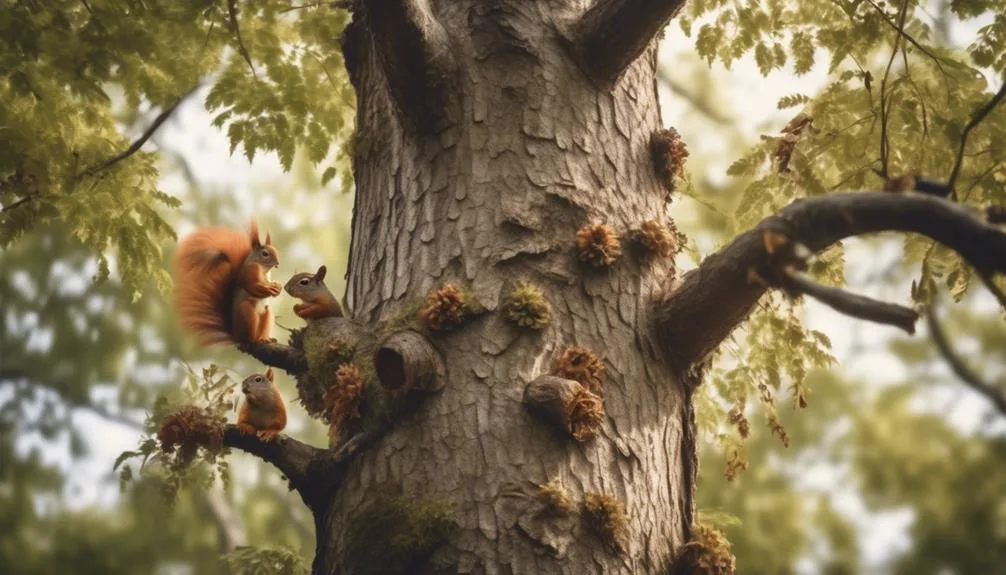Hickory trees are essential for the local environment, providing nutrients and a home for wildlife.
These tall trees have a big impact on the ecosystem, supporting the balance and health of the area.
Let's take a closer look at how these trees benefit the world around them.
Nutrient Cycling
Hickory trees play a crucial role in nutrient cycling within local ecosystems. They actively contribute to the redistribution and recycling of essential nutrients such as nitrogen, phosphorus, and potassium. These majestic trees aid in carbon sequestration, capturing and storing carbon dioxide to mitigate climate change.
Their extensive root systems also help with water filtration, preventing soil erosion and maintaining water quality. Hickory trees excel in nutrient absorption, drawing in vital elements from the soil and making them available to other plants and organisms. This process enhances ecosystem resiliency, promoting a healthy and balanced environment.
Wildlife Habitat
Teeming with diverse flora and fauna, the ecosystem nurtured by hickory trees provides a rich and vital wildlife habitat. Within this flourishing habitat, hickory trees play a crucial role in supporting various forms of wildlife, creating a balanced and sustainable environment.
Here's why the wildlife habitat provided by hickory trees is so essential:
- Biodiversity: Hickory trees attract a wide variety of wildlife, from birds and small mammals to insects and fungi, contributing to a thriving and diverse ecosystem.
- Forest Regeneration: The fallen hickory leaves and nuts create a nutrient-rich environment that supports the growth of new vegetation, providing essential food and shelter for wildlife.
- Wildlife Corridors: Hickory forests often create natural pathways for wildlife to travel, promoting genetic diversity and allowing animals to move between different habitats.
This rich wildlife habitat not only supports existing species but also encourages the sustainability and growth of the entire ecosystem.
Soil Stabilization
With their extensive root systems and nutrient-rich leaf litter, hickory trees play a crucial role in stabilizing the soil within their ecosystem. Erosion prevention is one of the key benefits provided by hickory trees. The intricate network of roots helps to hold the soil in place, preventing it from being washed away during heavy rains or strong winds.
Additionally, hickory trees contribute to water retention in the soil, ensuring that moisture is available for other plants and organisms within the ecosystem. Their deep-reaching root systems also aid in slope stability, anchoring the soil and reducing the risk of landslides or soil erosion on sloped terrain.
Biodiversity Support
Supporting a diverse range of plant and animal species, the stable ecosystem created by hickory trees fosters a thriving community of life. The intricate web of species interaction within the hickory tree's habitat enhances ecological balance, ensuring the survival of various organisms. Here's how hickory trees contribute to biodiversity support:
- Habitat Diversity: Hickory trees provide diverse habitats for numerous species, from insects to birds, creating a rich and varied ecosystem.
- *Insect Diversity*: The leaves, bark, and nuts of hickory trees attract a wide array of insects, which in turn support a variety of other wildlife.
- *Wildlife Shelter*: The dense foliage and sturdy branches of hickory trees offer shelter and nesting sites for birds, small mammals, and other creatures.
- *Food Sources*: The nuts produced by hickory trees are an essential food source for many animals, ensuring their survival and contributing to the overall biodiversity of the area.
Economic Benefits
Hickory trees contribute significantly to local economies through their valuable timber, culinary uses, and role in supporting various industries.
The timber industry benefits greatly from hickory wood, prized for its strength and flexibility. It's used in the production of furniture, cabinets, tool handles, and sporting goods.
Additionally, hickory nuts are used in culinary applications, adding flavor and nutrition to various dishes.
Furthermore, hickory trees play a crucial role in carbon sequestration, helping to mitigate climate change by absorbing and storing carbon dioxide from the atmosphere. This environmental benefit has the potential to translate into economic gains as industries and governments seek to offset carbon emissions.
Conclusion
In contemplating the role of hickory trees in local ecosystems, it becomes evident that their contribution is multi-faceted. From fostering nutrient cycling to providing crucial wildlife habitat and supporting biodiversity, hickory trees are indispensable.
Their impact resonates deeply, enriching both the environment and human livelihoods. Perhaps, in recognizing the intricate web of benefits they offer, we can cultivate a greater appreciation for the interconnectedness of our natural world.

My interest in trees started when I first saw the giant sequoias in Yosemite.
I was a teenager then, and I remember thinking, “I need to learn more about this.”
That moment stuck with me.
A few years later, I went on to study forestry at Michigan Tech.
Since graduating, I’ve worked in a mix of hands-on tree care and community education.
I’ve spent over ten years helping people understand how to plant, maintain, and protect the trees in their neighborhoods.
I don’t see trees as just part of the landscape.
They are living things that make a real difference in our daily lives.
